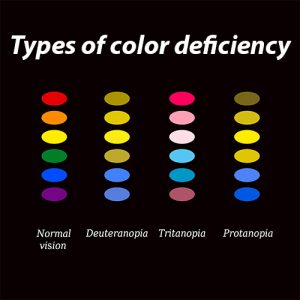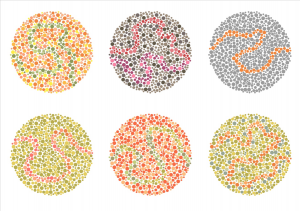What is color blindness?
People who have extreme color deficiency vision, more commonly known as color blindness, are unable to tell the difference among colors.
There are three variations of the condition, each based on photopigment defects in the three eye cones that respond to blue, green and red light. They are:
- red-green color blindness, which is the most common
- blue-yellow color blindness
- a complete inability to see colors—or total color blindness—which is a rare condition
How serious is color blindness?
Generally, the difficulties that arise from being color blind revolve around daily tasks. This means that red-green color blind children may have trouble seeing if a teacher writes on a green chalkboard with yellow chalk. They may also struggle with certain crayon colors or learning exercises that use color. If teachers are aware that the student is color blind, they can work around the issue.
For adults, color blindness can make reading traffic lights a challenge (many simply rely on the order of the lights, not the color, to navigate this). It can also pop up as a problem when it is time to buy—or get dressed in—clothes that match.
While troublesome, those with the condition typically find ways to work around it. What is most important is that they are diagnosed by an eye care professional, so they are aware that they may have challenges with certain visual tasks.
What causes color blindness?
There are a number of factors that can cause the condition. They are:
- Physical or chemical damage to the eye, the optic nerve, or parts of the brain that process color
- Cataract, a condition that occurs with aging and which causes the eye’s lens to cloud and yellow
- Genetics; inherited color blindness may present at birth, childhood or adulthood
Why are more men colorblind than women?
According to the National Eye Institute, about 8 percent of men with Northern European ancestry have red-green color blindness, compared to 0.5 percent of women. There is also a disproportionate number of color blind men of other ethnicities and racial backgrounds. This is because the genes responsible for inherited color blindness are x-linked, meaning they are related to the x chromosome. Females have two x chromosomes, whereas males have only one—and if that one carries the trait for color blindness, the man could develop it. For females, a functional gene on only one of the x chromosomes is enough to compensate for the loss on the other.
How is it diagnosed?
Eye care professionals use a variety of tests to diagnose color blindness, including:
- The Ishihara Color Test is used for red-green color blindness. People are shown a series of colored circles, each containing a collection of different color and sized dots. These dots form

Ishihara Color Test a shape that those with normal color vision will be able to see without difficulty. However, if one has red-green color blindness, it will be a challenge.
- The Cambridge Color Test uses similar visuals as the Ishihara test, but it is done on a computer monitor. Someone being tested tries to identify a C shape that is a different color from the background.
- The anomaloscope is an instrument that a person looks through and sees a circle. The upper half of the shape is a yellow light, the lower is a combination of red and green lights. Using a knob, the viewer adjusts the brightness of the two halves of the circle in order to achieve the same brightness and color.
- The HRR Pseudoisochromatic Color Test detects red-green color blindness using color plates.
- The Farnsworth-Munsell 100 Hue Test has a person take a set of blocks or pegs that are in the same color family, but shaded differently. They must arrange them in order of hue. The test measures the ability to discriminate subtle color changes and is usually used in industries—such as graphic design or food inspection—where accuracy of color perception is necessary.
What is the cure for colorblindness?
There is no cure, but there are a number of ways to mitigate the effects of the condition. These include:
- People with red-green color blindness may be able to use a special set of lenses to help them perceive colors more accurately. These lenses can only be used outdoors in bright lighting conditions.
- Visual aids can help people cope with color blindness. For example, there are smartphone apps that can greatly assist in telling the difference between colors.
To schedule an eye exam with the University Eye Center, call 📞 (888) 601-8811 or Request an Appointment online.